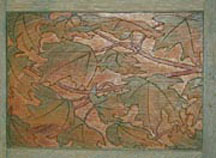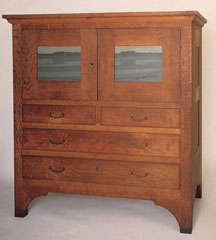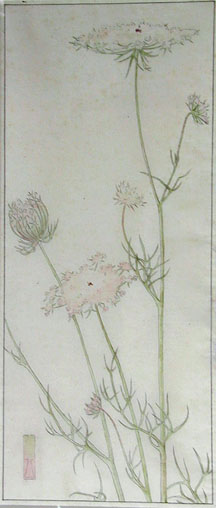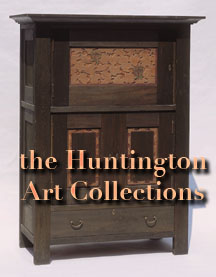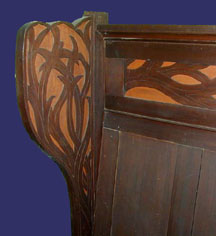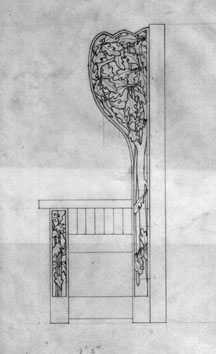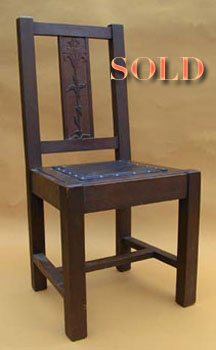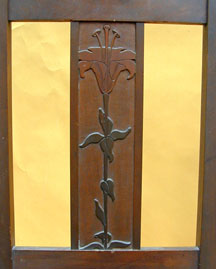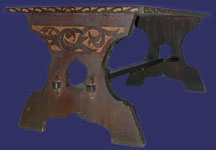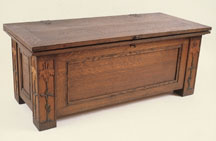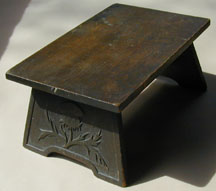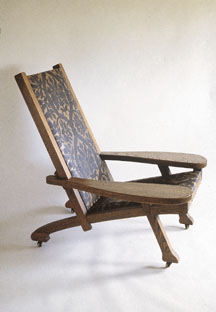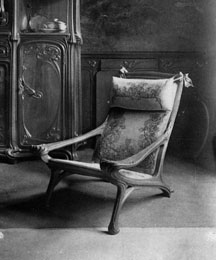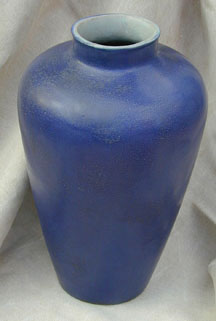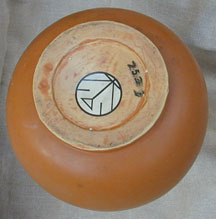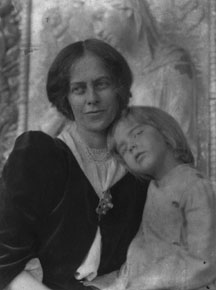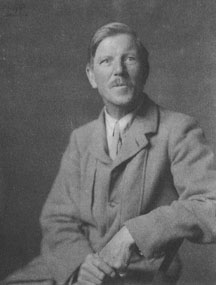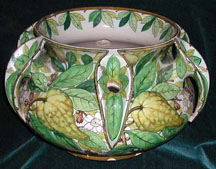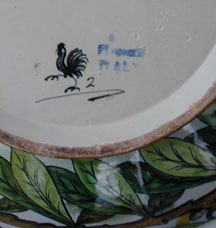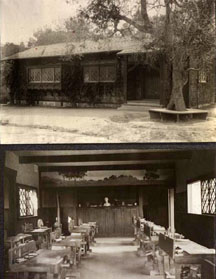BYRDCLIFFE FURNISHINGS AND HISTORY
Starting in 1976, I have been developing the story of Byrdcliffe utilizing the materials that remained in White Pines when Ralph and Jane Whitehead’s son Peter died in 1975. Most of the Byrdcliffe furniture we know today was scattered throughout White Pines where it suffered various degrees of neglect and well-meaning but damaging maintenance. For example, the polychrome maple leaf cabinet stood beneath a leaky skylight for years and I stopped a family member who was in the process of cleaning a tulip poplar design cabinet with “Old English” furniture polish (this polish contains a coloring agent and is nearly impossible to remove from an open finish such as is found on most Byrdcliffe furniture). In 1984, I removed the pieces chosen to be exhibited in the Delaware Art Museum exhibition. Later, pieces not in pristine condition were removed for storage in Pennsylvania. Much of the archival material has been placed at the Winterthur Museum and Library and most of the Byrdcliffe furniture is now in museums. Few of the furnishings and crafts from the Whitehead estate are still available for purchase. As the always limited supply dwindles, the prices have increased. The carved oak
“maple leaf” cabinet shown in detail above sold privately two years ago for $200,000.00. A similar cabinet with polychrome panels sold at auction recently for $99,000.00. On June 13th, 2002, Christie’s, NYC sold yet another cabinet for a record auction price of $240,000.
Although my research suggests that there were several pieces made, which were sold and could still be discovered, there is no way to predict what might be found or, if found, what the condition might be. A desk following Zulma Steele’s beautiful iris design was recently identified in Woodstock. Unfortunately, after the drop front was ineptly repaired, the entire piece was painted white. After careful restoration, the desk has been returned to White Pines where it serves as an eloquent study piece.
The objects on the list following represent the last of the important furnishings from the Whitehead estate:
The “wild carrot” cabinet is unique among known examples of Byrdcliffe furniture. I consider it to be a masterpiece among known examples of this rare furniture. The highly figured, varnished mahogany; the Macmurdo-inspired feet; and the realistically painted flowers are elements that appear on no other Byrdcliffe furniture. This highly important cabinet retains the original, unrestored finish in excellent condition. It is braned “Byrdcliffe Arts & Crafts Colony, 1904.” Offered with the cabinet are Steele’s drawing of the wild carrot panel and a period color rendering of the entire piece.
Height: 72 1/2"
Width: 40"
Depth: 16"
Provenance:
1904-1983: At “White Pines” the Byrdcliffe home of Jane and Ralph Radcliffe-Whitehead who were the principal founders of the community.
1983-1985: Exhibited in “Life by Design; The Byrdcliffe Arts & Crafts Colony”, catalogue number 8.
1985-1995: With the heirs to the estate of Peter Whitehead.
1995- present: Private collection, Wilmington, Delaware
This “tulip poplar” cabinet is one of two examples of this design known. Original inventory lists indicate that this example is constructed of “whitewood” or poplar . The motif of tulip poplar leaves and seed pods was designed by Edna Walker. This example retains the original soft green finish in fine condition.
This example retains the original hardware made by the “R&H Co.” New York.
A period color rendering accompanies this piece.
Height: 72 1/2"
Width: 48"
Depth: 21"
Provenance: and exhibition history:
1904-1983: At “White Pines” the Byrdcliffe home of Ralph Radcliffe Whitehead who was the principal founder of the community.
1983-1985: Exhibited in “Life by Design; The Byrdcliffe Arts & Crafts Colony”, catalogue number 4.
Note: A mistake was made by the catalogue designers when they used a black and white photograph of the oak tulip poplar cabinet with the brown color scheme and Byrdcliffe made hardware instead of a photograph of the “green stained poplar” cabinet that I actually installed in the exhibition.
1985-present: With the heirs to the estate of Peter Whitehead.
1999: Exhibited in “Arthur Wesley Dow: His Art and His Influence,” Spanierman Gallery, New York.
This settle represents a departure from the style of most Byrdcliffe furniture. It’s distinction may be attributed to the designer Dawson Dawson Watson who seems to have preferred the more sensuous outlines and patterns of the Art Nouveau style. Such settles were much favored by Arts & Crafts designers because they could be used to partition the open-plan living halls that were popular in small bungalows as well as larger houses such as the Whiteheads’ White Pines where the present example remained until 1984.
This settle, as designed by Watson, has broad swirling leaves carved in low relief and stained with dark brown against a bittersweet orange background. Another settle of the same design but with oak-leaf decorations by Edna Walker was planned, but it may not have been built. The piece is made of poplar and bears the Byrdcliffe brand as well as the original finish in very good, unrestored condition. Many working drawings accompany this piece.
Height: 68"
Width: 68"
Depth: 26"
Provenance and exhibition history:
1904-1983: At “White Pines” the Byrdcliffe home of Ralph Radcliffe Whitehead who was the principal founder of the community.
1983-1985: Exhibited in “Life by Design; The Byrdcliffe Arts & Crafts Colony”, catalogue number 22.
1985 to present: With the heirs to the estate of Peter Whitehead.
The tiger lily was chosen to be part of the Byrdcliffe logo. A set of dining-room furniture with Zulma Steele’s lily panels was designed for use in Bolton Brown’s Byrdcliffe house. Only four chairs and a charred table were saved when the house burned. All but the present chair are now in museum collections.
Steele used the lily design with various subtle modifications to decorate a lift-lid chest, a lamp stand, and a footstool. This chair is executed in cherry. The lily splat is colored with orange and green. The chair bears the Byrdcliffe brand and is in excellent original condition. The covering of the seat center is torn.
Height: 37 3/4"
Width: 18"
Depth: 15 1/2"
Provenance and exhibition history:
1904-1983: At “White Pines” the Byrdcliffe home of Ralph Radcliffe Whitehead who was the principal founder of the community.
1983-1985: Exhibited in “Life by Design; The Byrdcliffe Arts & Crafts Colony”, catalogue number 19.
1984 to present: With the heirs to the estate of Peter Whitehead.
This library table exhibits the idiosyncratic style of Dawson Dawson Watson and relates to a settle, a corner cabinet, and a chest that were characterized as “Tyrol” on original inventory sheets. As with the settle, an alternative design was made by Edna Walker that used oak leaves for decoration. This table is in good original, unrestored condition and several working drawings are available to the buyer.
Height: 27 1/4"
Width: 77"
Depth: 30 1/2"
Provenance and exhibition history:
1904-1983: At “White Pines” the Byrdcliffe home of Ralph Radcliffe Whitehead who was the principal founder of the community.
1983-1985: Exhibited in “Life by Design; The Byrdcliffe Arts & Crafts Colony”, catalogue number 17.
1985 to present: With the heirs to the estate of Peter Whitehead.
This oak blanket chest is one of four examples decorated with lilies known. Two are also in oak but appear to have a later varnish. Another was made in cherry or poplar and has a modern finish. This example retains the original, unvarnished finish in excellent condition. Original drawings accompany this piece.
Height: 20 1/4"
Width: 50 1/4"
Depth: 22 1/4"
Provenance:
1904-1983: At “White Pines” the Byrdcliffe home of Ralph Radcliffe Whitehead who was the principal founder of the community.
1983-1985: Exhibited in “Life by Design; The Byrdcliffe Arts & Crafts Colony”, catalogue number 9.
1985 to present: With the heirs to the estate of Peter Whitehead.
The ends of this cherry footstool have been carved with a thistle motif designed by Edna Walker. The finish is the original although the small size of this piece has made it susceptible to rough treatment that shows to some extent. Original drawings accompany this piece.
Height: 9 1/4"
Width: 20 7/8"
Depth: 13 1/2"
Provenance:
1904-1983: At “White Pines” the Byrdcliffe home of Ralph Radcliffe Whitehead who was the principal founder of the community.
1983-1985: Exhibited in “Life by Design; The Byrdcliffe Arts & Crafts Colony”, catalogue number 21.
1985 to present: With the heirs to the estate of Peter Whitehead.
The “Low Down Arm Chair” branded by Joseph P. McHugh, New York. This oak chair was bought by Ralph and Jane Whitehead for use at White Pines. It retains the original wood finish and the imitation leather covering on the back could be the original.
The design was inspired by several published European designs, but the Whiteheads might have seen similarities to a chair shown in a photograph of a chair marketed by S. Bing, Paris that was in their library.
This chair was exhibited in “The Distinction of Being Different: Joseph P. McHugh and the American Arts and Crafts Movement” Munson Williams Proctor Institute, 1994.
This extraordinary example of White Pines Pottery was made in the largest mold used by Ralph and Jane Whitehead in their attic ceramics studio. The exterior is glazed with a superb mat blue color. Ralph Whitehead excelled in the formulation of glazes that match the quality of the best of any of the other American art potteries. This example is 15" high and retains a paper label.
This White Pines Pottery vase is glazed in a rarely beautiful pumpkin-colored mat glaze. The form of the vase was taken from an ancient Persian vase that was photographed and measured with calipers to provide a guide for wood turners who produced a solid wood model from which the plaster mold was made. The vase is 14" high and retains a paper label.
This image of Jane Byrd McCall Whitehead and her son is signed by Eva Watson Schutze. Mrs. Whitehead is wearing a brooch designed by C. R. Ashbee. 8" X 6"
Ralph Radcliffe-Whitehead, shown in this photographic portrait signed by Eva Watson Schutze, together with his wife Jane envisioned an Arts & Crafts colony that eventually took form in Woodstock, New York. 8" X 6"
The Whiteheads purchased furniture and textiles directly from Morris & Company before they set up housekeeping in the United States. This Italian walnut cabinet was designed by George B. Jack. It or one identical to it was catalogue # 437 in the 1889 Arts & Crafts Exhibition in London. It was listed as having been made by L. Turner, H. Sidwell, and W. Cook.
Photographs of the interiors of Arcady, the Whiteheads’ California home, indicate that the cabinet once had two finials that are now missing. The cabinet is , otherwise, in very good, original finish.
Height: 51 1/2"
Width: 44"
Depth: 14"
Provenance and exhibition history:
Purchased by Ralph and Jane Whitehead directly from Morris & Co. circa 1890.
Used to furnish Arcady and later brought to White Pines where it hung in the “loom room” until 1983.
1976 to Present: The estate of Peter Whitehead
Catalogue # 64, “Life by Design”, Delaware Art Museum, 1984
“Designing Utopia: The Art of William Morris and his Circle,” Katonah Museum of Art, 1992.
The architect Halsey Ricardo, who designed ceramics for William DeMorgan, was a close friend of the Whiteheads. Although this piece does not appear to be the design of either Ricardo or DeMorgan, the latter commissioned pottery from the Italian firm of Maioliche Cantagalli in 1901. The well-known photograph of Jane Whitehead taken by Eva Watson Schutze show a lily sprouting from this vase.
Height: 10 1/2"
The Whiteheads commissioned this mural to decorate the school house they built for their sons at Arcady. The mural depicts the California shore line as it looked from their hillside in Santa Barbara. The oil on canvas painting (236" X 28") was removed from the school and brought to White Pines where it remained rolled in the attic until it was exhibited at “Arcady to Byrdcliffe: The Whiteheads’ Circle of Artists,” James Bakker Gallery, Boston, 1999.
Leonard Lester (1870-1952): Lester was a member of the Point Loma Theosophical Society, but before joining the community at Lomaland he maintained studios near the Whiteheads in Santa Barbara and Montecito. He painted a large mural for the school building at “Arcady” and evidently joined Jane and others for plein air painting sessions in the hills of Montecito. Some of the panels they painted were later incorporated into Byrdcliffe furniture.
“ Blue Hills”, oil on canvas board in original frame, 9" X 12" The painting shows the mountains near Byrdcliffe in Woodstock, New York
Zulma Steele (1881-1979): Steele and Edna Walker designed many of the decorations for Byrdcliffe furniture. Because they were Pratt graduates, their aesthetic is now assumed to have been influenced by Arthur Wesley Dow, who taught at the school. However, Steel painted the scenes around her in Woodstock in an impressionistic style owing little to Dow’s theories. Although her work at Byrdcliffe was primarily designing decorations for furniture, she is listed in the S.A.C.B. exhibition records as a textile designer and potter.


